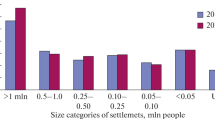Abstract
In this paper, the authors criticize the recent decision to expand Moscow’s territory in its administrative borders by 2.35 times. A significantly more reasonable decision would come from the central place theory and, first of all, from its relativistic modification that describes agglomeration as an extreme degree of compactness within an urban settlement network covering a territory of dozens or hundreds of thousands of square miles. We introduce and employ the concept of a dispersed central place defined as a polynucleated formation functioning as an integrated entity thanks to progress in intra-agglomeration transport systems. The development of a second hierarchical level, using dispersed central places, for example, Yaroslavl-Kostroma-Rybinsk, Vladimir-Kovrov-Ivanovo, and Tula-Novomoskovsk-Kaluga-Obninsk, will increase the degree of stability of the discussed settlement system. Dispersed central places can become an alternative to the federal capital in attracting migration flows from other regions and countries. The fourth dispersed central place-Voronezh-Lipetsk-Yelets-is expected to shape itself by 2030 under the second hierarchical level, and its development will bring more stability to the overall system.
Similar content being viewed by others
References
Vazhenin, A.A., Evolyutsionnye protsessy v sistemakh rasseleniya (Evolutionary Processes in Settlement Systems), Yekaterinburg: Ural. Otd., Ross. Akad. Nauk, 1997 Russian.
Losch, A., Prostranstvennaya organizatsiya khozyaistva (The Spatial Organization of Economy), Moscow: Nauka, 2007 Russian.
Ovchinnikov, N.F., Structure and symmetry, in Sistemnye issledovaniya 1964 g. (Systemic Studies of 1964), Moscow: Nauka, 1969 Russian.
Printsip sootvetstviya. Istoriko-metodologicheskii analiz (Conformity Principle: Historical-Methodological Analysis), Moscow: Nauka, 1979 Russian.
Shuper V.A. and Valesyan A.L., Spatial structure of urban settlement systems: stability versus changeability. Cybergeo // http://cybergeo.revues.org/2386
Christaller, W., Central Places in Southern Germany, New Jersey: Englewood Cliffs, 1966.
Parr, J.B., City hierarchies and the distribution of city size: a reconsideration of Beckmann’s contribution, J. Reg. Sci., 1969, vol. 9, no. 2, pp. 239–253.
Author information
Authors and Affiliations
Corresponding author
Additional information
Original Russian Text © V.A. Shuper, P.P. Em, 2012, published in Regional’nye Issledovaniya, 2012, No. 4(38), pp. 97–107.
Rights and permissions
About this article
Cite this article
Shuper, V.A., Em, P.P. Moscow city expansion: An alternative based on central place theory. Reg. Res. Russ. 3, 376–385 (2013). https://doi.org/10.1134/S2079970513040102
Received:
Published:
Issue Date:
DOI: https://doi.org/10.1134/S2079970513040102




